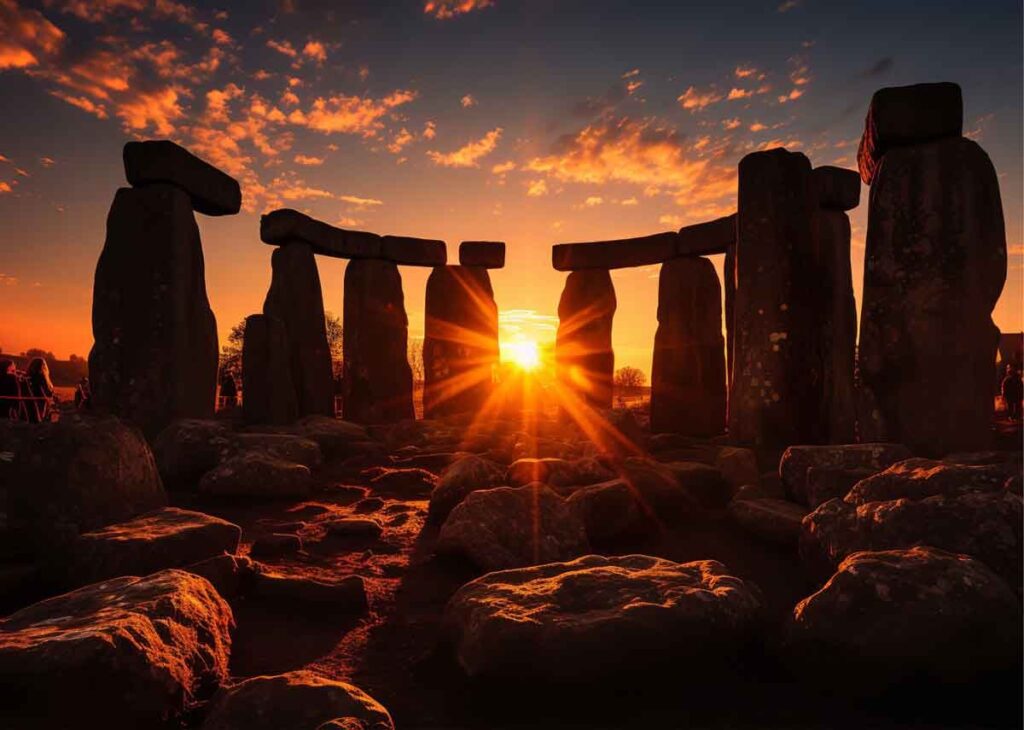
The winter solstice, often referred to as the “shortest day” and the “longest night,” marks a significant celestial event that has captivated human cultures for centuries. This astronomical phenomenon occurs annually, typically around December 21st in the Northern Hemisphere, signaling the official start of winter. To fully appreciate the winter solstice, let’s delve into the science behind it, explore its cultural significance, and examine how various civilizations have celebrated this celestial turning point throughout history.
Table of Contents
The Science Behind the Winter Solstice:
The winter solstice occurs when Earth’s axial tilt reaches its maximum point away from the sun. Earth’s axis is tilted approximately 23.5 degrees relative to its orbit around the sun. During the solstice, the Northern Hemisphere is tilted farthest from the sun, resulting in the shortest day and longest night of the year. Conversely, in the Southern Hemisphere, the summer solstice takes place, bringing the longest day and shortest night.
As Earth completes its orbit around the sun, the tilt of the axis causes the length of daylight to vary throughout the year. During the winter solstice, areas in the Northern Hemisphere experience the least direct sunlight, leading to colder temperatures and the onset of winter.

Read: How To Stay Healthy in Winter
Cultural Significance:
The winter solstice holds immense cultural significance across various societies, often symbolizing a metaphorical journey from darkness to light. Many ancient civilizations recognized the solstice as a pivotal moment in the cosmic cycle, influencing rituals, festivals, and religious observances.
- Yule Celebrations: In Norse traditions, the winter solstice is associated with Yule, a festival lasting 12 days. Yule celebrations included the burning of a Yule log, a symbolic act meant to bring light and warmth during the darkest time of the year.
- Roman Saturnalia: The Romans celebrated Saturnalia, a festival honoring the god Saturn, during the winter solstice. This festival was marked by feasting, gift-giving, and a temporary reversal of social roles, emphasizing the joyous and festive nature of the season.
- Chinese Dongzhi Festival: In China, the Dongzhi Festival is celebrated around the winter solstice, symbolizing the return of longer days and increased daylight. Families come together to enjoy special foods and mark the occasion with various customs.
- Pagan Traditions: Pagan communities often celebrate the winter solstice as a time of renewal and rebirth. The symbolism of the sun’s gradual return after the darkest day reflects themes of hope and the cyclical nature of life.
Modern Observations:
While contemporary societies may not always directly connect with the agricultural or survival implications of the winter solstice, its observance persists in various forms. Many people celebrate the holiday season during this time, incorporating traditions that have evolved over centuries.
- Winter Solstice Festivals: Some communities organize modern-day winter solstice festivals, featuring light displays, music, and art installations. These events celebrate the return of sunlight and the promise of longer days ahead.
- Connection with Nature: Others use the solstice as an opportunity to connect with nature, engaging in outdoor activities or taking time for personal reflection. The solstice serves as a reminder of the Earth’s natural rhythms and the interconnectedness of all living things.
Winter Solstice FAQ: Embracing the Celestial Turning Point
Q1: What is the winter solstice?
A1: The winter solstice is an astronomical event that occurs when Earth’s axial tilt is farthest from the sun, resulting in the shortest day and longest night of the year in the Northern Hemisphere. It typically happens around December 21st.
Q2: How does the winter solstice happen?
A2: Earth’s axis is tilted at approximately 23.5 degrees relative to its orbit around the sun. During the winter solstice, the Northern Hemisphere is tilted away from the sun, causing less direct sunlight and shorter daylight hours.
Q3: Does the Southern Hemisphere experience a winter solstice?
A3: No, while the Northern Hemisphere experiences the winter solstice, the Southern Hemisphere has its summer solstice, marking the longest day and shortest night of the year.
Q4: What is the cultural significance of the winter solstice?
A4: The winter solstice has deep cultural roots, symbolizing themes of renewal, rebirth, and the triumph of light over darkness. Many ancient civilizations celebrated this celestial event with festivals, rituals, and symbolic traditions.
Q5: How do different cultures celebrate the winter solstice?
A5: Various cultures have unique ways of celebrating. For example, Norse traditions include the Yule festival, Romans celebrated Saturnalia, and some Chinese communities observe the Dongzhi Festival. Modern celebrations often involve festivals, light displays, and outdoor activities.
Q6: Are there modern-day winter solstice celebrations?
A6: Yes, many communities organize winter solstice festivals that include light displays, music, and art installations. These events often emphasize the return of sunlight and the promise of longer days ahead.
Q7: Is the winter solstice connected to religious celebrations?
A7: Yes, the winter solstice is often intertwined with religious observances. For example, some Pagan communities see it as a time of spiritual significance, while Christians celebrate Christmas around the same time, symbolizing the birth of Jesus.
Q8: Do people observe any specific traditions during the winter solstice?
A8: Traditional practices include lighting candles, burning a Yule log, and engaging in activities that symbolize the triumph of light. In modern times, people may also use the solstice as a moment for personal reflection and connection with nature.
Q9: Does the winter solstice have any impact on weather patterns?
A9: While the solstice itself doesn’t directly influence weather, it marks the beginning of winter in the Northern Hemisphere. Colder temperatures and changing weather patterns are more a result of Earth’s axial tilt affecting sunlight distribution.
Q10: How can individuals celebrate the winter solstice?
A10: Celebrations can range from attending local festivals to creating personal rituals. Some people choose to spend time outdoors, appreciating nature, while others may engage in artistic or creative activities that symbolize the return of light.
The winter solstice serves as a timeless reminder of nature’s cycles and our connection to the cosmos, offering an opportunity for reflection, celebration, and the anticipation of brighter days ahead.
Our Take
The winter solstice, with its scientific underpinnings and rich cultural history, invites us to contemplate the cycles of nature and our place in the cosmos. As we experience the shortest day and longest night, we are reminded that even in the darkest moments, there is a promise of renewal and the eventual return of light. Whether celebrated through ancient traditions or modern festivities, the winter solstice serves as a universal symbol of hope, resilience, and the enduring cycle of life.
Check our some amazing web stories below.
What's Your Reaction?
One of my friends once said, I am in love with words and a zoned out poser... well, I will keep it the way it has been said! Besides that you can call me a compulsive poet, wanna-be painter and an amateur photographer











